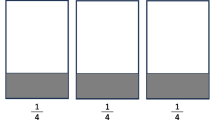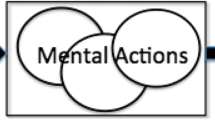Abstract
To make complex mathematics concepts accessible to students, teachers often rely on visual representations. Because no single representation can depict all aspects of a mathematics concept, instruction typically uses multiple representations. Much research shows that multiple representations can have immense benefits for students’ learning. However, some re-search also cautions that multiple representations may fail to enhance students’ learning if they are not used in the “right” way. For example, unless students can (1) properly interpret each individual representation and (2) make connections among multiple representations and the information they intend to convey, the use of multiple representations may actually confuse students rather than aid their learning. In this article, we review research-based principles for how to use multiple representations effectively so that they enhance student learning. Using fractions as an illustrative domain, we discuss how the choice of visual representation may affect student learning based on the conceptual aspects of the to-be-learned content emphasized by the representation. Next, we describe ways to help students interpret individual representations and to make connections among them. We illustrate these arguments with our own empirical research on fractions learning. We conclude by laying out open questions that future research should address.








Similar content being viewed by others
References
Acevedo Nistal, A., Van Dooren, W., Clarebout, G., Elen, J., & Verschaffel, L. (2009). Conceptualising, investigating and stimulating representational flexibility in mathematical problem solving and learning: a critical review. The International Journal on Mathematics Education, 41(5), 627–636.
Ainsworth, S. (2006). Deft: A Conceptual Framework for Considering Learning with Multiple Representations. Learning and Instruction, 16(3), 183–198. doi:10.1016/j.learninstruc.2006.03.001.
Ainsworth, S., Bibby, P., & Wood, D. (2002). Examining the Effects of Different Multiple Representational Systems in Learning Primary Mathematics. Journal of the Learning Sciences, 11(1), 25–61. doi:10.1207/S15327809JLS1101_2.
Ainsworth, S., & Loizou, A. (2003). The effects of self-explaining when Learning with text or diagrams. Cognitive Science: A Multidisciplinary Journal, 27(4), 669–681.
Airey, J., & Linder, C. (2009). A disciplinary discourse perspective on university science learning: Achieving fluency in a critical constellation of modes. Journal of Research in Science Teaching, 46(1), 27–49. doi:10.1002/tea.20265.
Behr, M. J., Post, T. R., Harel, G., & Lesh, R. (1993). Rational Numbers: Toward a Semantic Analysis - Emphasis on the Operator Construct. In T. P. Carpenter, E. Fennema & T. A. Romberg (Eds.), Rational Numbers: An Integration of Research. Hillsdale: Lawrence Erlbaum Associates.
Berthold, K., Eysink, T. H. S., & Renkl, A. (2008). Assisting self-explanation prompts are more effective than open prompts when learning with multiple representations. Instructional Science, 27(4), 345–363. doi:10.1007/s11251-008-9051-z.
Berthold, K., & Renkl, A. (2009). Instructional Aids to support a conceptual understanding of multiple representations. Journal of Educational Research, 101(1), 70–87. doi:10.1037/a0013247.
Bodemer, D., & Faust, U. (2006). External and mental referencing of multiple representations. Computers in Human Behavior, 22(1), 27–42. doi:10.1016/j.chb.2005.01.005.
Boyer, T. W., & Levine, S. C. (2012). Child proportional scaling: Is 1/3= 2/6= 3/9= 4/12? Journal of Experimental Child Psychology, 111(3), 516–533.
Boyer, T. W., Levine, S. C., & Huttenlocher, J. (2008). Development of proportional reasoning: Where young children go wrong. Developmental psychology, 44(5), 1478–1490.
Charalambous, C. Y., & Pitta-Pantazi, D. (2007). Drawing on a theoretical model to study students’ understandings of fractions. Educational Studies in Mathematics, 64(3), 293–316. doi:10.1007/s10649-006-9036-2.
Chi, M. T. H., Feltovitch, P. J., & Glaser, R. (1981). Categorization and representation of physics problems by experts and novices. Cognitive science, 5, 121–152. doi:10.1207/s15516709cog0502_2.
Cramer, K., & Wyberg, T. (2009). Efficacy of different concrete models for teaching the part-whole construct for fractions. Mathematical Thinking and Learning, 11(4), 226–257. doi:10.1080/10986060903246479.
Cramer, K., Wyberg, T., & Leavitt, S. (2008). The role of representations in fraction addition and subtraction. Mathematics teaching in the middle school, 13(8), 490.
de Croock, M. B. M., Van Merrienboër, J. J. G., & Paas, F. G. W. C. (1998). high versus low contextual interference in simulation-based training of troubleshooting skills: Effects on transfer performance and invested mental effort. Computers in Human Behavior, 14(2), 249–267.
DeLoache, J. S. (2000). Dual representation and young children’s use of scale models. Child Development, 71(2), 329–338. doi:10.1111/1467-8624.00148.
diSessa, A. A. (2004). Metarepresentation: Native competence and targets for instruction. Cognition and Instruction, 22(3), 293–331.
diSessa, A. A., & Sherin, B. L. (2000). Meta-representation: An introduction. The Journal of Mathematical Behavior, 19(4), 385–398. doi:10.1016/S0732-3123(01)00051-7.
Fabbri, S., Caviola, S., Tang, J., Zorzi, M., & Butterworth, B. (2012). The role of numerosity in processing nonsymbolic proportions. The Quarterly Journal of Experimental Psychology, 65(12), 2435–2446.
Gentner, D., & Markman, A. B. (1997). Structure Mapping in analogy and similarity. American Psychologist, 52(1), 45–56. doi:10.1037/0003-066X.52.1.45.
Gibson, E. J. (2000). Perceptual learning in development: Some basic concepts. Ecological Psychology, 12(4), 295–302. doi:10.1207/S15326969ECO1204_04.
Harden, R. M., & Stamper, N. (1999). What is a spiral curriculum? Medical Teacher, 21(2), 141–143.
Huttenlocher, J., Duffy, S., & Levine, S. (2002). Infants and toddlers discriminate amount: Are they measuring? Psychological Science, 13(3), 244–249.
Jacob, S. N., & Nieder, A. (2009). Notation-independent representation of fractions in the human parietal cortex. Journal of Neuroscience, 29(14), 4652–4657.
Jacob, S. N., Vallentin, D., & Nieder, A. (2012). Relating magnitudes: The brain’s code for proportions. Trends in Cognitive Sciences, 16(3), 157–166.
Jeong, Y., Levine, S. C., & Huttenlocher, J. (2007). The development of proportional reasoning: Effect of continuous versus discrete quantities. Journal of Cognition and Development, 8(2), 237–256.
Kellman, P. J., & Massey, C. M. (2013). Perceptual learning, cognition, and expertise. In B. H. Ross (Ed.), The psychology of learning and motivation (Vol. 558, pp. 117–165). New York: Elsevier Academic Press.
Kieren, T. E. (1993). Rational and fractional numbers: From quotient fields to recursive understanding. In T. P. Carpenter, E. Fennema & T. A. Romberg (Eds.), Rational numbers: an integration of research. Hillsdale: Erlbaum.
Koedinger, K. R., Corbett, A. T., & Perfetti, C. (2012). The knowledge-learning-instruction framework: Bridging the science-practice chasm to enhance robust student learning. Cognitive science, 36(5), 757–798. doi:10.1111/j.1551-6709.2012.01245.x.
Lewis, M. R., Matthews, P. G., & Hubbard, E. M. (2015). Neurocognitive architectures and the nonsymbolic foundations of fractions understanding. In D. B. Berch, D. C. Geary & K. M. Koepke (Eds.), Development of mathematical cognition: Neural substrates and genetic influences (pp. 141–160): Elsevier.
Mack, N. (1995). Confounding whole-number and fraction concepts when building on informal knowledge. Journal for Research in Mathematics Education, 26(5), 422–441.
Massey, C. M., Kellman, P. J., Roth, Z., & Burke, T. (2011). Perceptual learning and adaptive learning technology—developing new approaches to mathematics learning in the classroom. In N. L. Stein & S. W. Raudenbush (Eds.), Developmental cognitive science goes to school (pp. 235–249). New York: Routledge.
Matthews, P. G., & Chesney, D. L. (2015). Fractions as percepts? Exploring cross-format distance effects for fractional magnitudes. Cognitive Psychology, 78, 28–56. doi:10.1016/j.cogpsych.2015.01.006.
Matthews, P. G., & Lewis, M. R. (2017). Fractions we can’t ignore: The ratio congruity effect. Cognitive Science. doi:10.1111/cogs.12419.
McCrink, K., & Wynn, K. (2007). Ratio abstraction by 6-month-old infants. Psychological Science, 18(8), 740–745.
NCTM. (2000). Principles and Standards for School Mathematics. Reston: National Council of Teachers of Mathematics.
NCTM. (2006). Curriculum Focal Points for Prekindergarten through Grade 8 Mathematics: A Quest for Coherence. Reston, VA.
Ni, Y., & Zhou, Y.-D. (2005). Teaching and learning fraction and rational numbers: The origins and implications of whole number bias. Educational Psychologist, 40(1), 27–52.
NMAP (2008). Foundations for success: Report of the National Mathematics Advisory Board Panel: U.S. Government Printing Office.
NRC. (2006). Learning to think spatially. Washington, DC: National Academies Press.
Ohlsson, S. (1988). Mathematical meaning and applicational meaning in the semantics of fractions and related concepts. Number concepts and operations in the middle grades, 2, 53–92.
Post, T. R., Behr, M. J., & Lesh, R. (1982). Interpretations of rational number concepts. In L. Silvey & J. R. Smart (Eds.), Mathematics for the middle grades (5-9). Reston, VA: National Council of Teachers of Mathematics.
Rau, M. A. (2016). Conditions for the effectiveness of multiple visual representations in enhancing stem learning. Educational Psychology Review, 1–45. doi:10.1007/s10648-016-9365-3.
Rau, M. A., Aleven, V., & Rummel, N. (2013). Interleaved practice in multi-dimensional learning tasks: Which dimension should we interleave? Learning and Instruction, 23, 98–114. doi:10.1016/j.learninstruc.2012.07.003.
Rau, M. A., Aleven, V., & Rummel, N. (2015). Successful learning with multiple graphical representations and self-explanation prompts. Journal of Educational Psychology, 107(1), 30–46. doi:10.1037/a0037211.
Rau, M. A., Aleven, V., & Rummel, N. (2016). Supporting students in making sense of connections and in becoming perceptually fluent in making connections among multiple graphical representations. Journal of Educational Psychology. doi:10.1037/edu0000145.
Rau, M. A., Aleven, V., Rummel, N., & Pardos, Z. (2014). How should intelligent tutoring systems sequence multiple graphical representations of fractions? A multi-methods study. International Journal of Artificial Intelligence in Education, 24(2), 125–161. doi:10.1007/s40593-013-0011-7.
Renkl, A. (2005). The Worked-out Example Principle in Multimedia Learning. In R. Mayer (Ed.), The Cambridge handbook of multimedia learning (pp. 229–246). Cambridge: Cambridge University Press.
Schnotz, W. (2005). An Integrated Model of Text and Picture Comprehension. In R. E. Mayer (Ed.), The Cambridge handbook of multimedia learning (pp. 49–69). New York: Cambridge University Press.
Seufert, T. (2003). Supporting coherence formation in learning from multiple representations. Learning and Instruction, 13(2), 227–237. doi:10.1016/S0959-4752(02)00022-1.
Shanks, D. (2005). Implicit learning. In K. Lamberts & R. Goldstone (Eds.), Handbook of cognition (pp. 202–220). London: Sage.
Siegler, R. S., Carpenter, T., Fennell, F., Geary, D., Lewis, J., Okamoto, Y., … Wray, J. (2010). Developing effective fractions instruction: A practice guide. Washington, DC: National Center for Education Evaluation and Regional Assistance, Institute of Education Sciences, U.S. Department of Education.
Siegler, R. S., Thompson, C. A., & Schneider, M. (2011). An integrated theory of whole number and fractions development. Cognitive Psychology, 62(4), 273–296.
Singer, F. M. (2007). Beyond conceptual change: using representations to integrate domain—specific struct ural models in learning mathematics. Mind, Brain, and Education, 1(2), 84–97.
Singer, F. M. (2009). The dynamic infrastructure of mind—a hypothesis and some of its applications. New Ideas in Psychology, 27, 48–74.
Stern, E., Aprea, C., & Ebner, H. G. (2003). Improving cross-content transfer in text processing by means of active graphical representation. Learning and Instruction, 13(2), 191–203. doi:10.1016/S0959-4752(02)00020-8.
Sweller, J. (1990). Cognitive load as a factor in the structuring of technical material. Journal of Experimental Psychology; General, 119(2), 176–192. doi:10.1037//0096-3445.119.2.176.
Taber, K. S. (2013). Revisiting the chemistry triplet: drawing upon the nature of chemical knowledge and the psychology of learning to inform chemistry education. Chemistry Education Research and Practice, 14(2), 156–168. doi:10.1039/C3RP00012E.
Tversky, B. (2011). Visualizing thought. Topics in Cognitive Science, 3(3), 499–535. doi:10.1111/j.1756-8765.2010.01113.x.
Tversky, B., Zacks, J., Lee, P., & Heiser, J. (2000). Lines, Blobs, Crosses and Arrows: Diagrammatic Communication with Schematic Figures. In M. Anderson, P. Cheng & V. Haarslev (Eds.), International conference on theory and application of diagrams (pp. 221–230). Berlin/Heidelberg: Springer.
Uttal, D. H., & O’Doherty, K. (2008). Comprehending and learning from ‘visualizations’: a developmental perspective. In J. Gilbert (Ed.), Visualization: Theory and practice in science education (pp. 53–72). Netherlands: Springer.
Vallentin, D., & Nieder, A. (2008). behavioral and prefrontal representation of spatial proportions in the monkey. Current Biology, 18(8), 1420–1425.
van der Meij, J., & de Jong, T. (2006). Supporting students’ learning with multiple representations in a dynamic simulation-based learning environment. Learning and Instruction, 16(3), 199–212. doi:10.1016/j.learninstruc.2006.03.007.
van der Meij, J., & de Jong, T. (2011). The Effects of directive self-explanation prompts to support active processing of multiple representations in a simulation-based learning environment. Journal of Computer Assisted Learning, 27(5), 411–423. doi:10.1111/j.1365-2729.2011.00411.x.
Yang, Y., Hu, Q., Wu, D., & Yang, S. (2015). Children’s and adults’ automatic processing of proportion in a Stroop-like task. International Journal of Behavioral Development, 39(2), 97–104.
Author information
Authors and Affiliations
Corresponding author
Rights and permissions
About this article
Cite this article
Rau, M.A., Matthews, P.G. How to make ‘more’ better? Principles for effective use of multiple representations to enhance students’ learning about fractions. ZDM Mathematics Education 49, 531–544 (2017). https://doi.org/10.1007/s11858-017-0846-8
Accepted:
Published:
Issue Date:
DOI: https://doi.org/10.1007/s11858-017-0846-8




